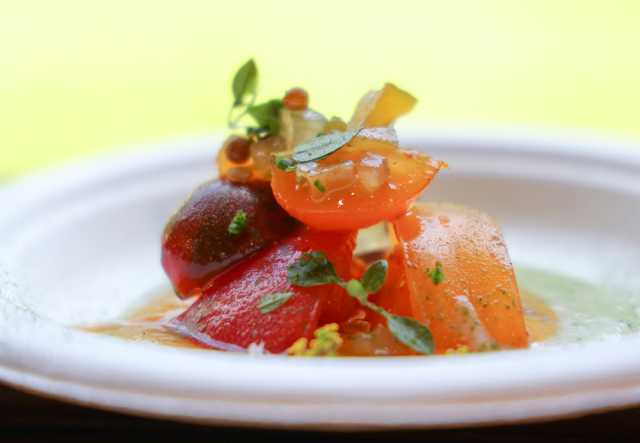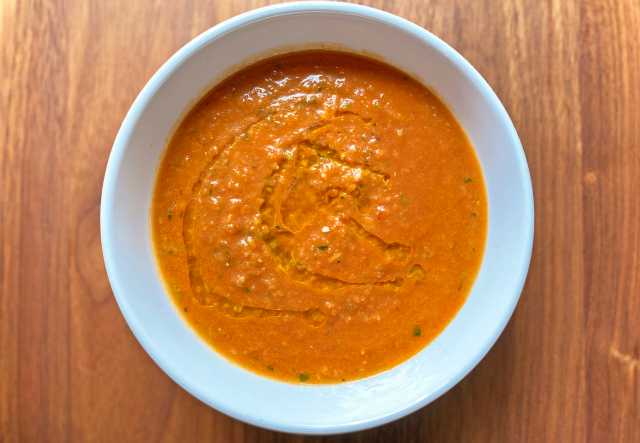Peak tomato season is upon us! Make this light sauce to enjoy the bounty and utilize those super-ripe tomatoes. It’s the tomato water that makes all the difference here — it offers a fresh tomato taste that you just can’t achieve with cooked down tomatoes.
Don’t get too bogged down in the details. Taste as you go, and add additional herbs or ingredients as you see fit. The sauce is delicious over pasta, and blistered shishitos, garlic chips, spring onion, or a little grated parmesan are all great additions to the final dish.
Summer Tomato Sauce
Yield: enough sauce for two hearty servings over pasta
Ingredients
- 2 pounds (roughly) ripe slicing or heirloom tomatoes for tomato water
- ½ teaspoon chili flakes
- handful of basil leaves, torn into small pieces
- 2–3 Tablespoons extra virgin olive oil
- 1 pint cherry tomatoes
- 1–2 Tablespoons butter
- salt to taste
Method: Sauce
- Make the tomato water (see method below). Plan to make the tomato water ahead of time, especially if they’re frozen, or if you want to let them drain overnight (the easiest method).
- Blister the cherry tomatoes. In a hot pan, add 1 tablespoon of oil and add your cherry tomatoes. The goal is to keep them relatively whole, just beginning to burst.
- Add 1 cup of tomato water and bring to a simmer. Add chili flakes and a pinch of salt.
- Add the butter, gently stirring until the butter melts. The sauce should thicken. For a vegan preparation, add some pasta water to your sauce to thicken it up instead of butter. The butter cuts the sweetness of the tomatoes and keeps the noodles from soaking up all the sauce, but can be omitted.
- Add the basil leaves and olive oil last. Stir to combine.
- Add another ½–1 cup tomato water (or however much it takes to reach your desired consistency and seasoning). Taste for salt and adjust if needed — remember, your tomato water has salt, too, so taste your sauce as it is coming together and adjust the recipe to make sure the end result is seasoned to your liking.
Method: Tomato Water
In this step, you’re essentially coaxing the tomatoes to give up their juices. It’s a great way to use tomatoes that are just past their prime and maybe a little too messy for a salad, but still have plenty of flavor. If you have a juicer, or a favorite juicing method, use it.
From the freezer:
- If you have tomatoes that are quickly overripening, put them into a plastic bag in the freezer for 4 hours. The tomatoes should be firm, but not hard. If they’ve been in the freezer for longer, allow them to thaw until they’re a little mushier.
- Remove the bag from the freezer and crush the tomatoes by hand in the bag, or pulse them into a food processor** until coarsely pureed.
- Add a good pinch of salt (this helps the tomatoes release their juices) to the puree and stir. Drain the puree through a colander lined with cheesecloth. Put the colander into a bowl to catch the the liquid (the tomato water). You can do this overnight in the fridge or, to speed things along, you can gently squeeze through the cheesecloth.
From fresh:
- Give them a rough chop, and add them to the food processor** with a good pinch of salt (the salt helps the tomatoes release their juices). Pulse until coarsely pureed. Alternatively, you can chop or slice your tomatoes by hand — you don’t need to be too particular here.
- Drain the puree through a colander lined with cheesecloth. Put the colander into a bowl to catch the liquid (the tomato water). You can do this overnight in the fridge or, to speed things along, you can gently squeeze through the cheesecloth.
**You can also use a blender for this step, but try not to overblend. A blender will whip more air into the mixture, producing a foam, which you’ll need to skim off.



